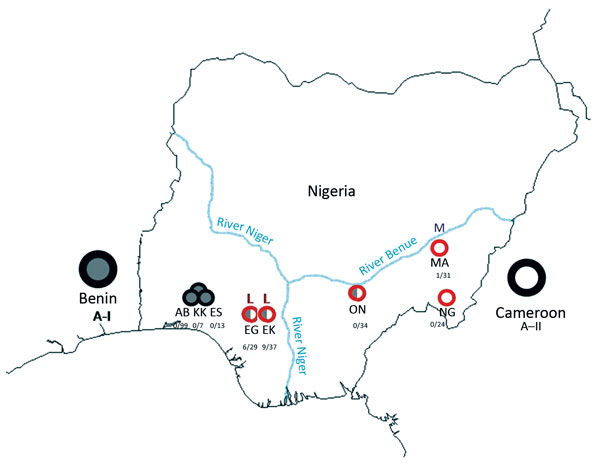Arenavirus Diversity and Phylogeography of Mastomys natalensis Rodents, Nigeria
Ayodeji Olayemi

, Adeoba Obadare, Akinlabi Oyeyiola, Joseph Igbokwe, Ayobami Fasogbon, Felix Igbahenah, Daniel Ortsega, Danny Asogun, Prince Umeh, Innocent Vakkai, Chukwuyem Abejegah, Meike Pahlman, Beate Becker-Ziaja, Stephan Günther, and Elisabeth Fichet-Calvet
Author affiliations: Obafemi Awolowo University, Ile-Ife, Nigeria (A. Olayemi, A. Obadare, A. Oyeyiola, J. Igbokwe); Ambrose Alli State University, Ekpoma, Nigeria (A. Fasogbon); Benue State University, Makurdi, Nigeria (F. Igbahenah, D. Ortsega); Irrua Specialist Teaching Hospital, Irrua, Nigeria (D. Asogun, C. Abejegah); Nigerian Montane Forest Project, Ngel-Nyaki, Nigeria (P. Umeh); Federal Medical Centre, Jalingo, Nigeria (I. Vakkai); Bernhard Nocht Institute for Tropical Medicine, Hamburg, Germany (M. Pahlman, B. Becker-Ziaja, S. Günther, E. Fichet-Calvet)
Main Article
Figure 1

Figure 1. Sites at which Mastomys natalensis rodents were captured in Nigeria during January 2011–March 2013. Red circles represent sites within the Lassa fever–endemic zone; black circles represent sites outside the Lassa fever–endemic zone. Within the circles, gray indicates M. natalensis phylogroup A-I rodents; white indicates M. natalensis phylogroup A-II rodents; both colors within 1 circle indicate that rodents of both phylogroups were present at that site. Numbers under each site indicate number of arenavirus-positive M. natalensis rodents/number of M. natalensis captured. L indicates sites with Lassa virus–positive M. natalensis rodents; M indicates sites with Mobala-like virus–positive M. natalensis rodents. AB, Abagboro 07°32′38.0′′N, 04°30′47.2′′E; KK, Kako 07°41′26.3′′N, 04°37′09.8′′E; ES, Esira 07°42′04.7′′N, 04°39′19.4′′E; EG, Eguare-Egoro 06°46′22.7′′N, 06°05′32.5′′E; EK, Ekpoma 06°44′29.1′′N, 06°06′17.6′′E; ON, Onmba-Abena 07°38′27.5′′N, 08°24′23.6′′E; MA, Mayo-Ranewo 08°49′27.2′′N, 10°55′15.2′′E; NG, Ngel-Nyaki 07°05′30.8′′N, 11°05′27.9′′E.
Main Article
Page created: March 16, 2016
Page updated: March 16, 2016
Page reviewed: March 16, 2016
The conclusions, findings, and opinions expressed by authors contributing to this journal do not necessarily reflect the official position of the U.S. Department of Health and Human Services, the Public Health Service, the Centers for Disease Control and Prevention, or the authors' affiliated institutions. Use of trade names is for identification only and does not imply endorsement by any of the groups named above.
